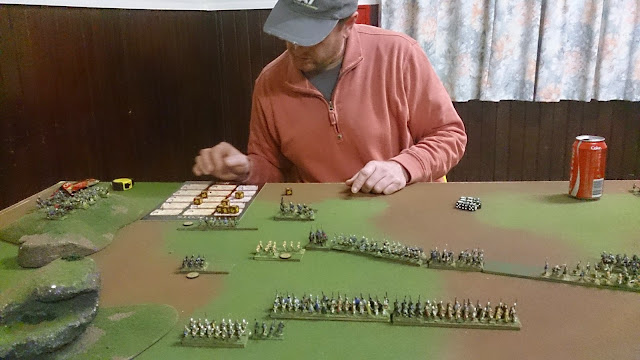Mike & Steve's French v. Jim & Mark's Austrians
This is the battle where Ney with his Corps crossed the Danube and defeated von Reisch's Austrian Corps to open the road to Ulm. Most of the information I used to design the scenario is from Jeff Berry's excellent blog post at
http://obscurebattles.blogspot.com.au/2013/12/elchingen-1805.html
Both sides have about 15,000 men, but the French were better troops and better commanded. I modelled this by making the Austrians 5 dice in combat and command 8 to the French 6 and 9. I made Ney 10 & Reisch 7. While the numbers are pretty even, the French have more points (906 to 727). I fudged the OOB's a bit to make them simpler. I scaled the battlefield at about 40" = 1km to fit all salient features on, which made the battalions a bit out of scale so it's a bit more crowded than it should be - a price to pay for using 28mm figs.
The Austrians start in their historical deployment in and around the villages of Unter- & Ober-Elchingen with a small advanced force defending a damaged bridge. This pic is taken behind Unter-Elchingen.
This pic is taken from behind Ober-Elchingen looking towards the bridge. The river on the table is a branch of the Danube, the Danube & its bridge is off table The Austrians have some Grenz, grenadiers and artillery on the flood plain to dispute the crossing.
Reich pulled his grenadiers & artillery back to the village leaving the grenz to make a nuisance of themselves.
The French deploy their 1st division in from of Ober-Elchingen and march the 2nd to its right. The escarpment hides the troops on the plateau from those on the flood plain.
The French 1st division attacks Ober -Elchingen. Their 2nd division is mostly deployed. Their cavalry is also on the field. The Austrians make a masterly show of inaction.
As both French infantry divisions attack, the Austrian left suddenly comes to life and advances. The infantry advance is as slow as usual, but the cavalry gallop ahead.
The French 1st division is trying to blast the enemy out fo the village with musket and shot, but only make slow progress. Their 2nd division breaks one Austrian battalion, but reinforcements but the Austrian counter attack on their flank turns the tide. The Austrian cuirassiers are pushing the French dragoons back on the left
The French cavalry have been beaten, but they retired behind their infantry before they were broken. The French 2nd division has broken under the Austrian counterattack.
At this point the lines have broken apart and there is a lull in the action. As it was 10 o'clock real time, time was called. We estimate that we got through about 15 turns, but the real battle started at 8am, so there's way to go before dark at around 6pm.
The Austrian cavalry is too blown to attack fresh infantry. The right flank Austrian infantry division is also badly mauled. Their small advance guard & their artillery have broken. They have 2 relatively fresh divisions and still hold Ober-Elchingen, but their counterattack has stalled due to the slow advance of their rear echelon.
The 1st French division is on half strength and verging on breaking, their 2nd division is broken, their cavalry is on half strength and blown. They have 2 fresh divisions, one deployed & the other in the process of doing so. The 2 spent divisions are being withdrawn behind the fresh ones.
The Austrians came very close to breaking 3 French divisions and gaining a great victory, but their command problems have, as usual, resulted in a disorganised attack which though successful requires reorganising before it can go on.
The prospect of attacking 2 fresh French divisions with plenty of artillery support is not attractive to the Austrians. Nor is the prospect of renewing the attack with just 2 divisions attractive to the French.
So the battle appears to be a draw. But the Austrian wargamers are claiming victory on the grounds that they did much better than in the original battle.
In the real battle Ney's advance guard forced the crossing then charged up the hill & took half of Ober-Elchingen while the main body crossed over and deployed. The Austrians broke when the French attacked in force. Ney only used his first 2 infantry divisions and his cavalry. His 2 smaller infantry divisions weren't needed.
It's a good question why von Reisch didn't defend the bridgehead more strongly. In our wargame, the Austrian players decided to let the French cross, putting up only token resistance at the bridgehead, intending to counterattack them in the hope that a great victory could be gained by defeating the French with their backs to a river. It very nearly worked - if the Austrian cavalry had broken the French cavalry quickly (and the French saved a couple of break tests at bad odds to prevent it) the French position would have been fatally compromised. Maybe this was also Reisch's plan but he wasn't up to executing it.







































